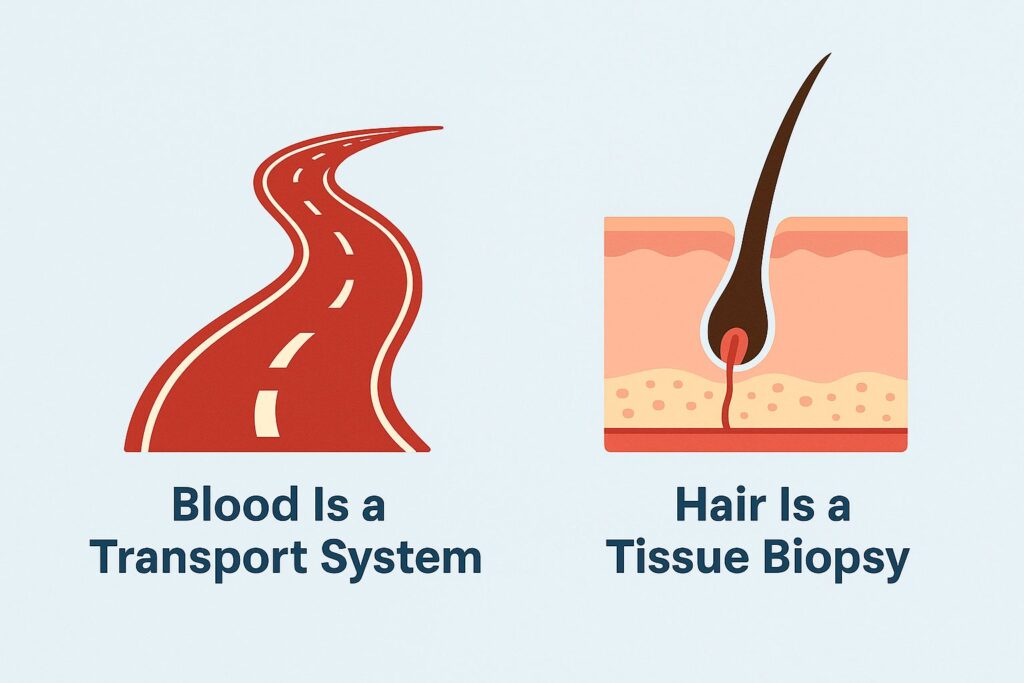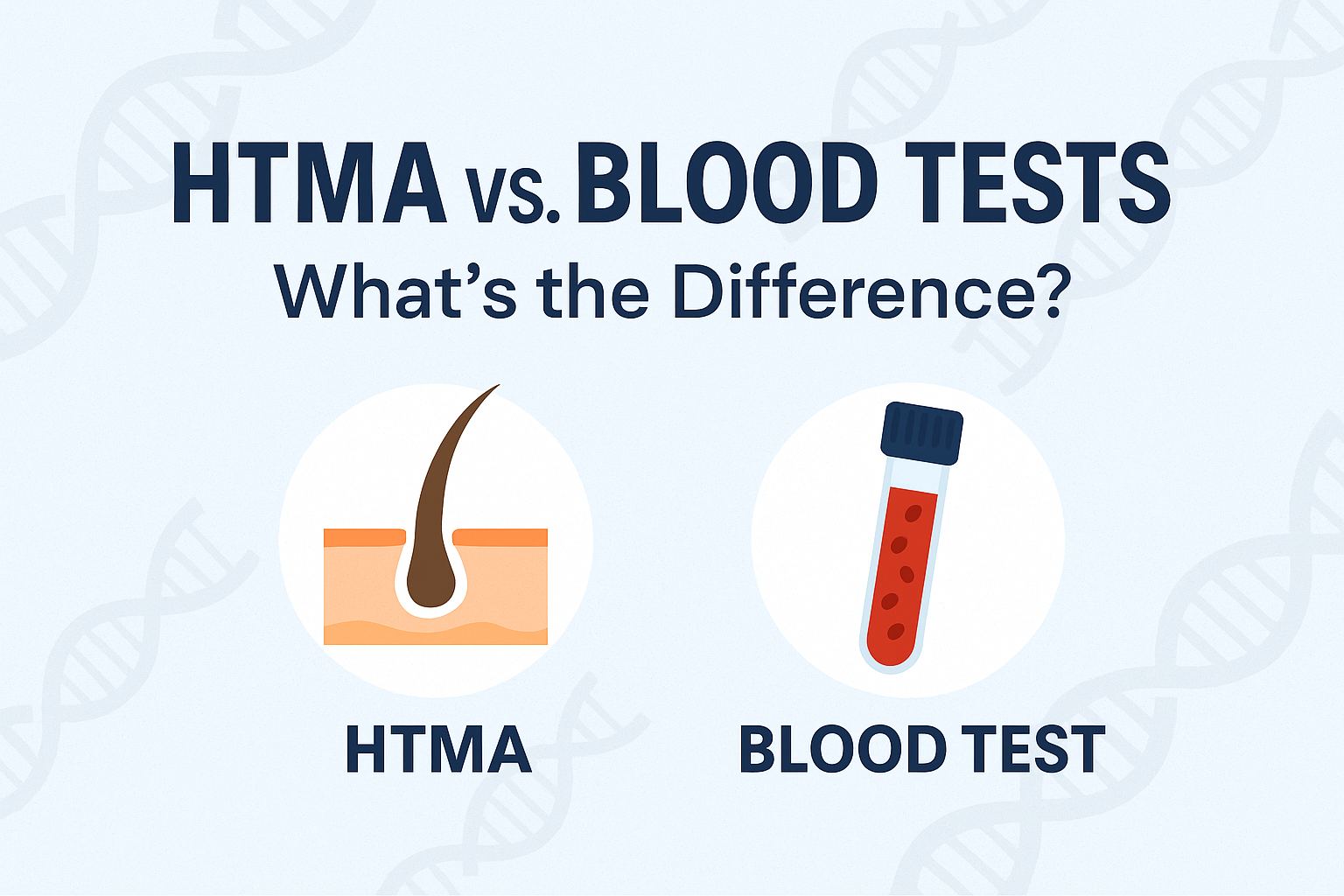Many clients ask: “Why do you use hair tests instead of blood tests?”
It’s a fair question. Some even try to confirm their HTMA readings with blood, urine, or other lab tests — and end up more confused than before.
Here’s why that happens: hair and blood measure two completely different worlds inside your body.
Think of your body like a city.
Blood is the highway system — constantly on the move, delivering supplies and picking up waste.
Hair is part of the infrastructure — it records what’s been built, stored, and excreted over time.
Contents
- Blood Is a Transport System. Hair Is a Tissue Biopsy.
- Blood Stays Stable — Even When You’re Running on Empty
- Blood Tests Show the Short-Term Picture. Hair Tests Show the Long-Term Pattern.
- Blood Is Protected. Hair Is an Excretory Tissue (How Blood vs. Hair Detect Toxic Metals).
- Hair Is Non-Essential. Blood Is Essential.
- Why Tissue Tests Catch What Blood Tests Miss
- Hair and Blood Work Best Together
- Misconceptions About Hair Testing
- Is Hair Testing Accurate and Reliable?
- So… Which Test Should You Choose?
Blood Is a Transport System. Hair Is a Tissue Biopsy.

Hair is a soft tissue of the body, just like skin. That’s why HTMA is considered a tissue biopsy — only non-invasive.
Blood, on the other hand, is not a tissue — it’s a transportation medium. It carries oxygen, hormones, nutrients, and waste between your organs and cells.
Because blood is the “highway,” its chemistry must remain incredibly stable. If it changes too much, you’d literally die.
Hair, however, reflects what your body is storing or discarding over weeks to months, giving a long-term metabolic snapshot.
So while blood tells you what’s circulating right now, hair tells you what’s actually happening inside your cells.
Blood Stays Stable — Even When You’re Running on Empty
You can have major mineral imbalances in your tissues and still show “normal” results on a blood test.
That’s because your body works hard to keep blood levels steady — even when the rest of you is running on fumes.
If excess copper is locked away in your tissues, it won’t appear high in your blood unless it’s being actively released.
Blood acts like a calm messenger, hiding the struggle so the body can keep going.
It will even borrow minerals from storage — like pulling calcium from your bones — just to keep blood readings in range.
That’s how your blood calcium can look “fine” even while your bones quietly lose density (the setup for osteoporosis).
In short, blood chemistry shows how your body is surviving, while tissue chemistry shows how your body is adapting.
This isn’t just theory — research backs it up.
A 2015 study in the Journal of Trace Elements in Medicine and Biology found that while dietary changes barely affected minerals in the blood, they significantly changed mineral levels in hair — concluding that “the hair showed to be a better biological indicator for mineral status … than the serum.”1
Blood Tests Show the Short-Term Picture. Hair Tests Show the Long-Term Pattern.
Blood tests are great when you need quick answers — like checking for infection, inflammation, or hormone changes.
But blood is sensitive. It reacts to what you eat, how stressed you are, and even how you slept last night.
Eat a sugary breakfast? Your blood sugar spikes.
Get stressed? Cortisol and sodium rise within minutes.
Hair works differently. It grows slowly, locking in minerals over several weeks.
That means it gives you a steady, long-term view — one that isn’t thrown off by what happened this morning.
Think of it like this:
Checking your blood is like glancing at your speedometer right now.
Checking your hair is like looking at your average speed for the whole trip.
In short:
Blood gives a snapshot. Hair tells the story.
Blood Is Protected. Hair Is an Excretory Tissue.
Your body uses hair as a safe dumping ground for toxins like mercury, arsenic, lead, cadmium, or aluminum. Blood is too essential to allow these metals to circulate for long, so it moves them out quickly and stores them in deeper tissues like the liver, bones, nervous system, and hair.
This is why toxic metals often do not show up in blood tests unless the exposure is extremely recent. After a short time, blood levels fall — not because the metals are gone, but because the body has relocated them into storage.
To see the long-term picture, we need to look at tissue, not circulation.
How Blood vs. Hair Detect Toxic Metals
(This is where the difference becomes obvious.)
| Metal | Blood Test Shows | HTMA Shows | Why This Matters |
|---|---|---|---|
| Arsenic | Detectable only for 1–3 days after exposure. | Reflects storage & excretion over weeks to months. | Blood may look “normal” even when long-term arsenic toxicity is present. |
| Mercury | Shows only recent intake (e.g., seafood or fillings). | Shows mercury stored in nerves, thyroid, liver & active detox release. | Blood can be “normal” while neurological or thyroid symptoms continue. |
| Lead | Appears in blood only during initial exposure (about 30–45 days). | Detects chronic storage in bones & soft tissues. | Blood lead normalizes while lead continues affecting cognition & behavior. |
| Cadmium | Often missed unless exposure is heavy or ongoing. | Shows cadmium stored in kidneys, liver & released under stress. | Common in smokers; usually invisible on blood tests. |
| Aluminum | Clears from blood quickly after exposure. | Shows cumulative buildup & excretion rate. | Chronic exposure from cookware, deodorant, and water is best seen in hair. |
Real-World Examples
Arsenic
Arsenic clears from the bloodstream in 24–72 hours, then moves into hair, nails, and the digestive lining.
This is why forensic investigations use hair and nails — not blood — to confirm arsenic exposure.
So a person may have “normal” blood arsenic while still experiencing symptoms of chronic arsenic burden.
Mercury
Mercury binds to proteins and relocates into nerves, glands, and the brain.
Once stored, blood mercury drops, even while symptoms like anxiety, insomnia, tremors, or thyroid issues continue.
A “normal” blood mercury level does not mean mercury is gone — it may simply mean the body has parked it somewhere deeper.
Blood tells us what the body is dealing with today. Hair tells us what the body has been holding onto.
Hair Is Non-Essential. Blood Is Essential.
The body won’t waste precious minerals on non-essential tissues like hair when you’re depleted. If your hair is dull or falling out, that’s a clue minerals are being redirected to more important organs.
Blood, however, must stay balanced. Even in illness, it stays within tight limits — which is why blood results often appear “normal” even when tissues are exhausted.
Why Tissue Tests Catch What Blood Tests Miss
Example 1 — Calcium “normal,” but bones weakening: Your blood calcium looks fine because the body is stealing it from bones to maintain equilibrium. An HTMA would reveal the true low tissue calcium.
Example 2 — Lead exposure “disappears” from blood: After ingestion, lead levels remain high in blood for about 30 days, then drop as it moves into storage. The danger isn’t over — it simply shifts. Hair testing reveals it clearly.
Hair and Blood Work Best Together
Blood and HTMA aren’t rivals — they complement each other.
Blood gives the short-term “status report,” while hair provides the long-term “trend analysis.”
Testing all 21 minerals measured in HTMA through blood would be costly and still miss the deeper picture. Used together, they offer a complete view of both immediate function and long-range adaptation.
Misconceptions About Hair Testing
HTMA doesn’t simply show what you eat — it shows how your body is using what you eat.
- You may take magnesium daily yet see low levels in hair — stress or absorption issues can deplete it faster than you replace it.
- You might avoid salt but still have high hair sodium — chronic stress raises adrenal output and sodium levels.
That’s why HTMA interpretation requires experience. It reflects diet, stress, hormones, emotions, and detox pathways all together — not just nutrient intake.
Is Hair Testing Accurate and Reliable?
When done by a trusted lab like Analytical Research Labs (ARL), HTMA is extremely accurate. ARL does not wash hair samples, preserving true mineral content. Testing uses atomic absorption spectroscopy — a proven method used for environmental and soil analysis for decades.
Modern HTMA can detect minerals at parts-per-billion precision, comparable to advanced medical labs.
So… Which Test Should You Choose?
| If you want to measure: | Best test: |
|---|---|
| Hormones, blood sugar, infection, organ enzymes | Blood test |
| Stress patterns, metabolism, adrenal & thyroid activity, toxic metals, mineral reserves | Hair test (HTMA) |
Blood = the highway. Fast, reactive, always moving.
Hair = the history. Steady, long-term, revealing.
If your goal is to understand energy, stress, and detox patterns, HTMA dives deeper — right into the tissues where the real story lives.
Ready to Stop Guessing and Start Understanding Your Body?
If you’re tired of being told “your labs look normal” while you still feel exhausted, anxious, inflamed, wired-but-tired, or just not yourself — your minerals are likely telling a different story behind the scenes.
That’s what HTMA reveals.
It doesn’t just measure what’s circulating today.
It shows what your body has been coping with for weeks or months:
- Stress + adrenal output
- Thyroid slowdown and burnout patterns
- Blood sugar and mood swings
- Mineral depletion from chronic stress
- Hidden toxic metals the body has stored away
- The why behind fatigue that doesn’t go away
This is your long-term metabolic blueprint.
And once you see the pattern — we can change it.
→ Order your Hair Tissue Mineral Analysis (HTMA)
(with personalized analysis + a clear, step-by-step plan)
Get a non-invasive test that tells you what your blood tests can’t:
what’s really happening at the cellular level, where your energy is made.
References
- Ghorbani A., et al. (2015). Effects of Dietary Mineral Intake on Hair and Serum Mineral Status. J. Trace Elem. Med. Biol. Contexts where hair reflected mineral status better than serum due to longer-term incorporation (equine model; still informative for matrix behavior). Abstract.

